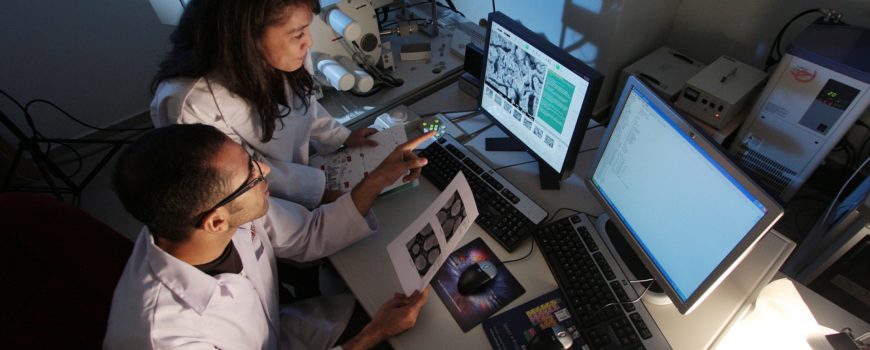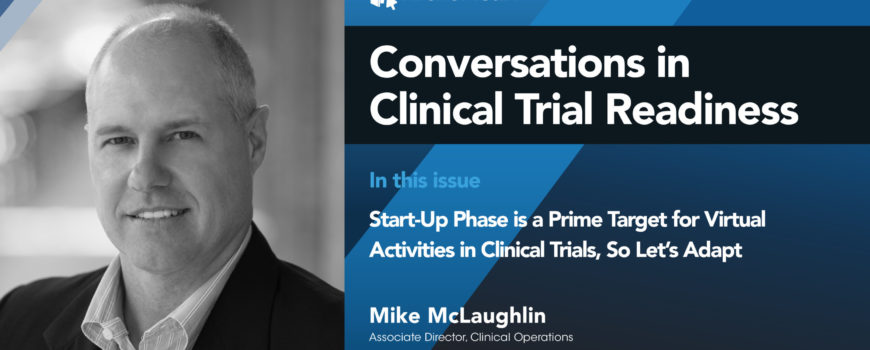Making it through the clinical trial start-up process is critical for any study – and takes a lot of effort under normal circumstances. But today, with the need to conduct more and more clinical operations remotely – it’s even more challenging.
The good news is that there is a way forward, because as our recent survey and report revealed, study start-up is a priority for virtualization.
Since we can’t rely on the procedures we’ve used for years, how do we resume or start-up a trial in this new virtual world with new untested processes? How do we do it right? Let’s take a look at some actionable steps.
Deliver the Investigator Meeting with Virtual Meeting Technology
Our recent report revealed the PI meeting is a major target for a digital enablement. Prior to COVID-19, only 33% of the respondents to the survey felt PI meetings could be conducted virtually. But now – 65% of Sponsors believe that a virtual meeting can be just as — or even more — effective as a face-to-face one.
If you’re preparing to make this a capability in your organization, don’t make the mistake of thinking you can just repurpose your standard PI meeting content and deliver it via a web meeting tool. To really succeed with a virtual meeting, you will need to transform the agenda and design a different overall experience.
65% of Sponsors believe that a virtual meeting can be just as — or even more — effective as a face-to-face one.
If you’re preparing to make this a capability in your organization, don’t make the mistake of thinking you can just repurpose your standard PI meeting content and deliver it via a web meeting tool. To really succeed with a virtual meeting, you will need to transform the agenda and design a different overall experience.
There are four key steps you should take to effectively virtualize the investigator meeting, all of which we describe fully in our recent blog “Running a Virtual Investigator Meeting in 4 Steps.”
To summarize, those four steps are:
- Get your technology right. There are numerous technologies you can use to deliver a virtual meeting – from those that are specialized for clinical trials to those that just host a video. Make sure you choose the right one for your purposes.
- Plan and deliver a virtual-first agenda. Moving to a virtual meeting does raise the risk of losing your audience faster. Make sure you rework your content in a way that will improve attendee engagement and the outcome of your meeting.
- Evaluate learning with analytics. A key benefit of digitizing content delivery and training is the rich data! Be sure to take advantage of the insights you can glean. For example, these data can inform site selection, site initiation, and monitoring decisions.
- Demonstrate the effectiveness of your virtual meeting. If you’re putting in the work, take advantage of the outcomes downstream – for example, in proving you were more effective in site selection.
Inform Final Site Selection with Data from the Virtual PI Meeting
Our COVID-19 report showed half of respondents sought to use virtual methods exclusively for site selection, In fact, 70% of Pharmaceuticals respondents said they plan to replace in-person activities with virtual delivery for this important clinical trial start-up activity.
This could mean great things for clinical trial start-up timelines. The average time to form a site list is around 2-3 months. The biggest benefit of virtualizing how you assess and select investigators and sites is speed. You can deliver it faster when you eliminate travel and dramatically improve decision making by gathering intelligence about the attendees and their readiness earlier.
So how do we do this? Normal procedures involve the PI meeting as well as an on-site evaluation of the facility and staff. We can virtualize so much of that process using a virtual training platform like Ready, which offers assessment capabilities that greatly increase your likelihood of selecting the most capable sites.
Using a tool like this allows you to answer the critical questions for selecting the right sites to start-up, like:
How prepared is the site to recruit the right study patients?
This is a critical priority in site selection, and the easiest to validate with a virtual process. For example, our clients use Ready to deliver content virtually to not only train – but also assess investigators and sites on their understanding of the protocol, eligibility criteria, familiarity with the patient population, and other indicators. This paints a truly accurate picture of whether a site can enroll.
Does the site have qualified and sufficient personnel to conduct the study?
Again, with a virtual model, you can more easily engage and evaluate additional site personnel beyond the PI to better assess (at scale) the capabilities of a site’s study team. Delivering training and assessment via a virtual, on-demand model allows you to be more inclusive and provides site personnel more flexibility to participate at a time and place that fits their already busy schedules.
Can the site use the electronic equipment and systems required?
In a virtual model, you can deliver targeted training and evaluation around the use of critical electronic systems and other equipment more effectively to the right site personnel, increasing the chances for better start-up execution.
Utilize the blend of a virtual assessment with the delivery of study content to create a more informed site selection process. In the past, many trial teams had to rely on too little data or subjective information in choosing sites for a trial.
Today, with virtual site selection methods – you don’t have to be limited. Let the data point you to the right sites who are ready to enroll and conduct the study.
Site Initiation Visits Can Go Virtual, too
Once you’ve selected your sites, we know there’s still a lot of work to do to activate them so they can start enrolling. Creating a virtual process to do this will help you in both the short-term and future studies.
And it’s an area that the industry is focusing on: across our recent survey, 84% plan to increase their use of virtual delivery of training during site initiation. 50% overall plan to replace in-person meetings wherever possible for the SIV.
84% plan to increase their use of virtual delivery of training during site initiation. 50% overall plan to replace in-person meetings wherever possible for the SIV.
There are major tasks you can virtualize here: documentation, site staff training, and the site initiation visit itself. There are numerous tools to help you acquire necessary documentation and contract agreements from the sites, for example, which reduces time a great deal.
But training the site staff and effectively virtualizing the meeting are areas of site activation that have remained manual for far too long. It’s a perfect use case for the deployment of remote and virtual technologies. And – if you’re planning to take your PI meetings virtual, you can and should use the same technology you adopt there for virtualizing the site initiation visit. By doing so, you can:
- Create efficiency and scale (reduce travel, optimize staff assignments)
- Reduce the work necessary to develop and deliver the training
- Ensure consistency in what site staff are learning and evaluate their actual preparedness
- Quickly identify risks in specific sites and staff ahead of the site initiative visit
- Enable trial leaders to focus on the most critical study objectives for each site
- Complete visits faster and with better outcomes – so that sites can begin enrolling patients sooner
In order to successfully virtualize your SIV, you need to consider the steps we wrote about recently in our blog on preparing your content for virtual training.
Start with objectives for your site staff training. An example of an objective could be: “Site staff must be able to disqualify a subject that doesn’t meet criteria.” By starting with the objectives you wish to achieve, you can refocus every additional step you take to get there.
Create your agenda with the objectives in mind. Create an outline – and tie each step in your outline back to your objectives. Protocols are rarely optimized for staff, doctor, or personnel consumption, but your training must be.
Use multimedia to encourage site staff engagement. Charts, graphs, and simple images are all effective to engage people visually with concepts.
Reduce your workload by reusing resources – and linking them in. You can encourage curiosity by adding additional, optional resources to your curriculum. It’s likely you’ve used some in creating your content already – so share what you already pulled!
Use scenarios instead of multiple choice questions to assess decision making. You probably did case studies or an exercise in a large group at investigator meetings previously. Use the same activities for site staff to retain consistency.
If you need to engage site staff over time, build in a follow up plan to encourage retention. Perhaps it’s a weekly email with a scenario, asking them to apply it. Or a short poll you send asking for responses each week to engage their memory.
Getting the Clinical Trial Technology Right
I’ve mentioned the technology you use a few times in this article. It’s critical that you select the right tool for your purposes.
If you’re going to invest the time and resources in making the clinical trial start-up activities virtual, you want the resulting outcome to be a foundation for the future. And our recent study reveals that most of the industry is going this way:
- 74% are adopting technology that supports virtual activities everywhere possible.
- 49% are converting all clinical operations meetings to virtual ones.
If you want to get the right clinical trial solution for the job, we’ve created a simple checklist that can help you.
Make the Clinical Trial Start-Up Your Priority
The trial study start-up is a complex set of processes, with many steps and people involved. The more complex the protocol, as well – the more risk there is to the timeline.
And if study timelines are not met in the trial start-up, it greatly impacts the likelihood of missing other study milestones in the future. This is why it’s so important to prioritize the virtualization and efficiency of the clinical trial start-up. The ability to make many of these processes virtual will reduce preventable delays, and likely surface the risk of others so they can be avoided.
Technology has become the cornerstone for most of the workplace today, and now the clinical operations industry is moving to virtualize across the trial lifecycle. Want more information about the clinical trial start-up trends in the survey? The report is available now.








